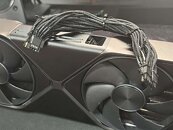- Joined
- Aug 19, 2017
- Messages
- 2,963 (1.06/day)
NVIDIA's high-TDP flagship GPU, the GeForce RTX 5090, appears to cause additional headaches for users, not including the high power bill. According to a Reddit user, we now have the first documented case of a melted power connector on NVIDIA's flagship GeForce RTX 5090 Founders Edition, reigniting concerns over high-wattage GPU safety from the last generation. While playing Battlefield 5, Reddit user ivan6953 detected a burning odor and immediately shut down their system, only to discover severe damage to both the RTX 5090's 12V-2×6 connector and their ASUS ROG Loki SFX-L PSU. The user had employed a Moddiy 12VHPWR cable, marketed as ATX 3.0/PCIe 5.0-compliant and rated for RTX 5090's 600 watts of power. Despite claims of secure installation—audible clicks at both ends—the cable melted at 500-520 W load, charring connectors on the GPU and PSU.
Notably, the same cable had powered an RTX 4090 FE for two years without issue. NVIDIA's RTX 5090 FE ships with a redesigned adapter featuring a longer, more flexible cable and an angled connector to reduce strain in compact builds. NVIDIA asserts that no incidents have occurred with its bundled adapter, emphasizing compliance with the updated 12V-2×6 standard, which shortens sensing pins to prevent power flow if connections loosen. Hence, an older connector can not provide 100% secure usage despite the user thinking that the sensing pins are touching properly.




A second case reported by Spanish YouTuber Toro Tocho involved a melted PSU-side connector, though the GPU remained undamaged. This resulted from worn connectors or improper seating despite user assurances of correct installation. RTX 5090 owners should avoid third-party adapters and rely solely on NVIDIA's included cable or PSU-native connectors. Regular inspections for discoloration, wear, or bending near connectors are also advised, particularly for systems with high power consumption. While NVIDIA investigates, the takeaway is clear: cutting corners on power delivery risks costly hardware failures. The RTX 5090's melting woes appear isolated to unofficial accessories—a small solace for early adopters navigating the pitfalls of the high-TDP GPU era.
View at TechPowerUp Main Site | Source
Notably, the same cable had powered an RTX 4090 FE for two years without issue. NVIDIA's RTX 5090 FE ships with a redesigned adapter featuring a longer, more flexible cable and an angled connector to reduce strain in compact builds. NVIDIA asserts that no incidents have occurred with its bundled adapter, emphasizing compliance with the updated 12V-2×6 standard, which shortens sensing pins to prevent power flow if connections loosen. Hence, an older connector can not provide 100% secure usage despite the user thinking that the sensing pins are touching properly.




A second case reported by Spanish YouTuber Toro Tocho involved a melted PSU-side connector, though the GPU remained undamaged. This resulted from worn connectors or improper seating despite user assurances of correct installation. RTX 5090 owners should avoid third-party adapters and rely solely on NVIDIA's included cable or PSU-native connectors. Regular inspections for discoloration, wear, or bending near connectors are also advised, particularly for systems with high power consumption. While NVIDIA investigates, the takeaway is clear: cutting corners on power delivery risks costly hardware failures. The RTX 5090's melting woes appear isolated to unofficial accessories—a small solace for early adopters navigating the pitfalls of the high-TDP GPU era.
View at TechPowerUp Main Site | Source









